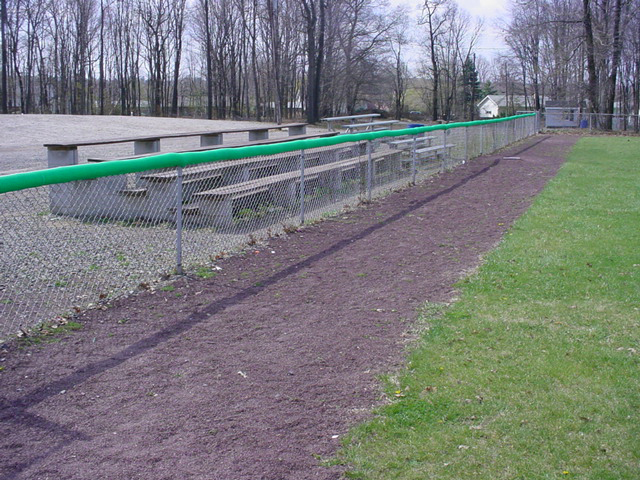It may be winter right now, but the first peek of warm weather in 2020 isn’t all that far away; and with that warm weather comes invasive vegetation and weeds. That makes the winter months the perfect time to be thinking about your athletic facilities, fields, and turf and the areas that surround them. Do you have a plan and a budget for vegetation management?
For athletic facilities, sports and recreational fields, even those with synthetic turf, vegetation problems can start appearing in the early spring, especially if the winter serves up conditions conducive to vegetation growth. The National Oceanic and Atmospheric Administration’s recent winter outlook is calling for a warmer-than-usual winter throughout much of the United States, and increased precipitation across a large northern swath of the country.
A warmer winter may lead to vegetation emerging earlier than usual in some areas. Combined with increased precipitation, a warmer winter could mean a vegetation explosion ahead of the spring sports season, depending on a field’s geographic locale.
When it comes to vegetation management, think beyond field care and take a holistic approach to your plan. What areas are part of your player and visitor experience? Does the presence of excess vegetation in these areas impact guests, pose hazards, or increase your labor costs?
What problems can excess vegetation cause?
Weeds and unwanted vegetation are often thought of as a mere aesthetic issue. Although aesthetics are certainly important to many sports organizations, there are other problems that come hand-in-hand with vegetation growth.
For many athletic facilities, the presence of weeds creates a continual need for manual care and treatment of fields. Crabgrass, thistle, and clover growing in areas adjacent to athletic fields can become a seed source and re-invade fields throughout the season.
Vegetation creates a harborage and sometimes a food source for a variety of pests, among them mice, rats, mosquitoes and stinging pests. The presence of any of these pests can pose potential health risks. Rodents will utilize vegetation to hide and shelter, and can cause structural and equipment damages, as well as contaminate food and surfaces. Mosquitoes, which rest on vegetation during the day or breed in stagnant water where vegetation blocks drainage, can carry and spread diseases such as West Nile virus and Eastern Equine Encephalitis, putting your visitors and players at risk. Stinging pests such as bees can hover near clover or other flowering plants, bringing with them a sting risk. In some situations, stings can be extremely dangerous, resulting in anaphylactic shock.
Some vegetation, such as ragweed, can create an unpleasant experience for both sports participants and observers, serving as a source of allergens.
Excess vegetation in some areas could potentially pose trip and fall hazards, especially when walking trails to fields are overgrown.
In areas where drought or lack of precipitation is an issue, dead or dry vegetation can create an increased fire hazard. This hazard risk can increase when the vegetation is in close proximity to electrical or heat sources.
Common areas where vegetation management is needed
Vegetation management should extend beyond field care to all areas that impact the experience of visitors to your facility. This might include secondary areas that may be “out of sight, out of mind.” Common areas where vegetation management programs can be useful include:
- Parking lots (whether paved, gravel, or dirt)
- Walking trails or paths to fields
- Concession stand areas
- Areas under bleachers or seating
- Fence lines
- Areas around pools
- Drainage ditches
How to budget for vegetation management
Most sports field professionals are thinking about budgeting for field maintenance and potentially landscaping, but vegetation management extends beyond these critical elements.
Vegetation management, involves surveying an area and the conditions around it, removing any existing overgrowth, applying pre-emergent products to control the vegetation that is already there and prevent new vegetation from growing. Most importantly, a professional vegetation management plan will typically come with a warranty to ensure that excess vegetation remains at bay during the entire growing season.
Budgeting for vegetation management requires taking a 360-degree view of your facility. In determining pricing for a vegetation management program, a professional will typically ask the following questions:
- What vegetation are we trying to control?
- Does the vegetation need to be controlled year-round or seasonally?
- What areas of your facility are associated with additional manual maintenance?
- Is the area adjacent to wooded areas that could promote additional vegetation growth?
- What areas does the public see/what areas are critical to aesthetics?
- Does the vegetation create any potential safety or health risks?
- Does vegetation impede traffic, create pedestrian hazards, or occlude access roads?
Vegetation management plans should be customized to address a facility’s unique concerns, but are typically priced by acre or square footage, depending on the type of treatment being performed. Vegetation that is dense or has grown in height may add additional expense to a program by increasing the cost of initial treatment.
Start thinking about vegetation management now
It’s never too early to start thinking about putting a vegetation management plan in place. In fact, winter is the perfect time to get started.
If you know the areas of your facility that are subject to excess vegetation and weeds throughout the warm weather season, a vegetation management professional can likely come out and determine the best program and treatment measures for you now, before growing season even begins. With the right program in place, vegetation will be a non-issue for your facility in 2020.
Editor’s note: This material was provided by Rentokil Steritech, and was written by Dwayne Hess, a product manager with Rentokil Steritech, and a veteran professional with more than 30 years of experience in vegetation management and turf and ornamental landscape care.


